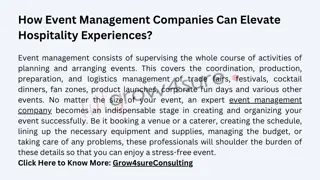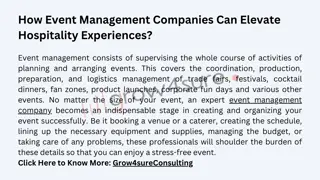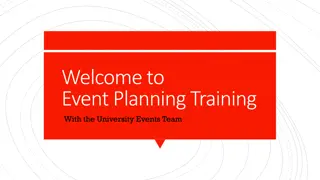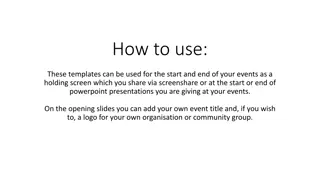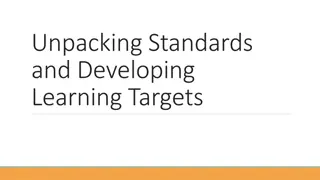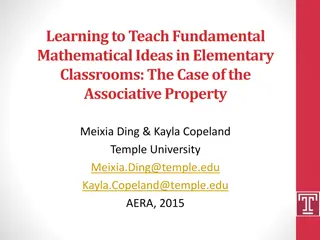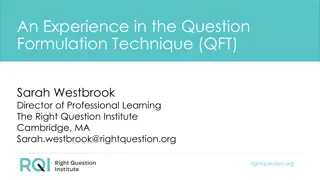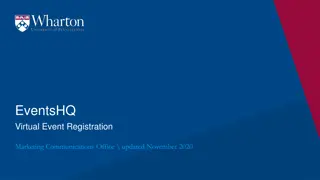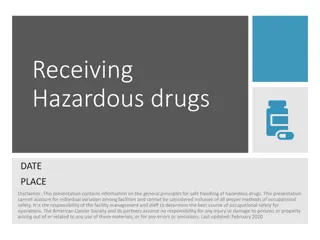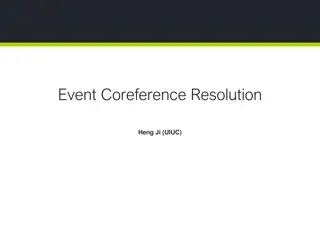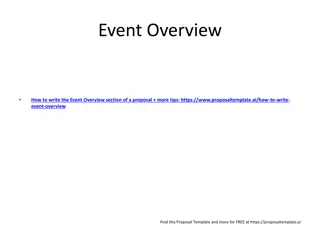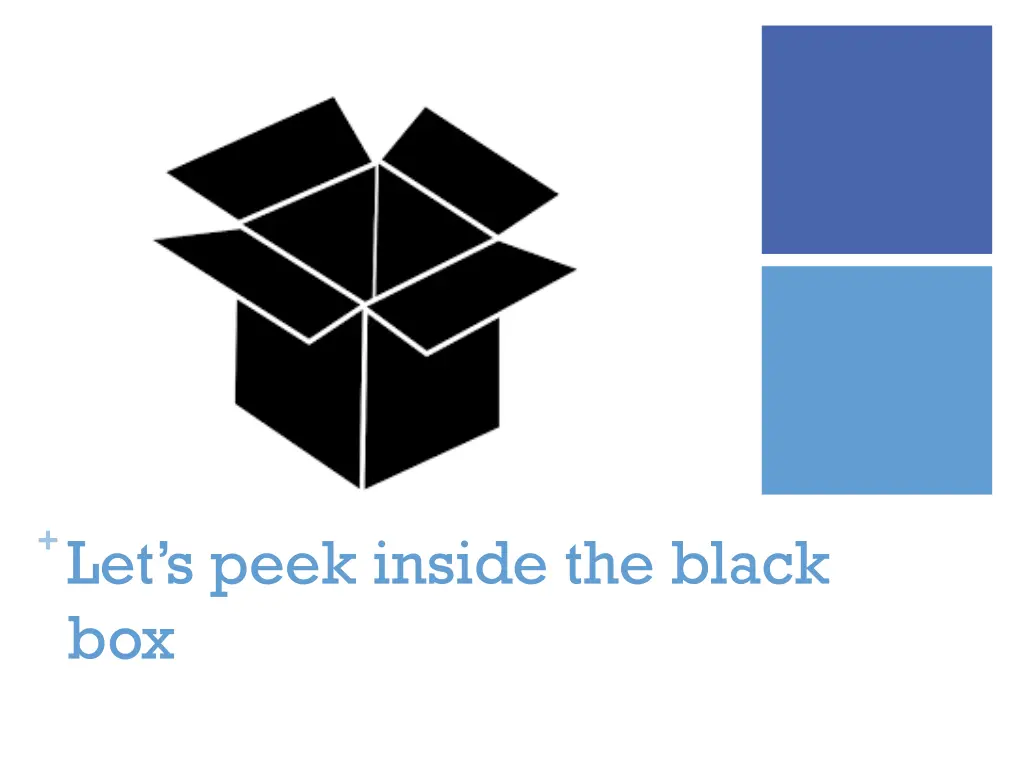
Enhancing Critical Thinking Through Question Formulation Technique
Explore the power of the Question Formulation Technique (QFT) to stimulate divergent and convergent thinking abilities. Engage in a process that encourages curiosity, rigor, metacognitive reflection, and classroom exploration, leading to improved questioning skills and enhanced intellectual inquiry.
Download Presentation

Please find below an Image/Link to download the presentation.
The content on the website is provided AS IS for your information and personal use only. It may not be sold, licensed, or shared on other websites without obtaining consent from the author. If you encounter any issues during the download, it is possible that the publisher has removed the file from their server.
You are allowed to download the files provided on this website for personal or commercial use, subject to the condition that they are used lawfully. All files are the property of their respective owners.
The content on the website is provided AS IS for your information and personal use only. It may not be sold, licensed, or shared on other websites without obtaining consent from the author.
E N D
Presentation Transcript
+Curiosity and Rigor Three thinking abilities with one process
+The QFT, on one slide 1) Question Focus 2) Produce Your Questions Follow the rules Number your questions 3) Improve Your Questions Categorize questions as Closed or Open-ended Change questions from one type to another 4) Prioritize Your Questions 5) Share & Discuss Next Steps 6) Reflect 1. Ask as many questions as you can 2. Do not stop to discuss, judge or answer 3. Record exactly as stated 4. Change statements into questions Closed-Ended: Answered with yes, no or one word Open-Ended: Require longer explanation
+ Thinking in many different directions DIVERGENT THINKING
+Narrowing Down, Focusing CONVERGENT THINKING
+ From Divergent to Convergent "Questions are the engines of intellect, the cerebral machines which convert energy to motion, and curiosity to controlled inquiry." David Hackett Fischer Historians' fallacies: Toward a logic of historical thought, 1971
+ From Divergent to Convergent [The QFT] helps me by getting me to think about questions on my own it gets my mind in motion to think about the questions other people make." 8thgrade student in James Brewster s U.S. history class Gus Garcia Young Men s Leadership Academy, Austin, TX, 2015
+ Thinking about Thinking METACOGNITIVE THINKING
+Student Reflection The way it made me feel was smart because I was asking good questions and giving good answers. -Boston 9th grade remedial summer school student
+ Exploring Classroom Examples
+Educators use the QFT for many purposes, including: Engagement Knowledge Acquisition Formative Assessment Summative Assessment And more Making Questions Flow by Rothstein, Santana, & Minigan, 2015 http://rightquestion.org/wp-content/uploads/2015/08/2015-Making-Questions-Flow.pdf
+The Question FOCUS (QFocus) The QFocus is what students are asking questions about related to the content you are teaching. The QFocus can be: A statement or phrase A picture A simple math problem or equation
+ Question Focus Design Basics Just one requirement for the QFocus: It should NOTbe a question *Key Tip for Designing an Effective QFocus: The simpler, the better.
+ Classroom Example: Kindergarten Teacher: Jennifer Shaffer, Walkersville, MD Topic: Non-fiction literacy Purpose: To engage students prior to reading a nonfiction text about alligators
+Student Questions Is the alligator camouflaged? Why do the babies have stripes? Are those baby crocodiles? Is it a mom or dad crocodile? What is the green stuff? Why are they in the water so low? 1. 7. Where are they going? 8. Why are the baby alligator s eyes white and the mom s black? 9. Why are baby alligators on top of the momma alligator? 10. Why does momma or daddy have bumps on them? 2. 3. 4. 5. 6.
+ Classroom Example: 4th Grade Teacher: Deirdre Brotherson, Hooksett, NH Topic: Math unit on variables Purpose: To engage students at the start of a unit on variables
+Question Focus 24 = + +
+Student Questions 1. Why is the 24 first? 2. What do the smiley faces mean? 3. Why are there 3 smiley faces? 4. How am I suppose to figure this out? 5. Is the answer 12? 6. Can I put any number for a smiley face? 7. Do three faces mean something? 8. Do the numbers have to be the same because the smiley faces are the same? 9. What numbers will work here? 10. Does it mean 24 is a really happy number? 11. Can we replace each smiley face with an 8? 12. Do any other numbers work? 13. Can we do this for any number? 14. Does it always have to be smiley faces? 15. Do we always have to use three things?
+ Classroom Example: High School Teacher: Daniel Fouts, Des Plaines, IL Topic: 12th Grade Government unit on the American presidency at moments of crisis Purpose: To engage students at the start of the unit and to help students select a topic for an independent project
+Question Focus Nearly all men can handle adversity; but if you really want to test a man s character, give him power. https://www.loc.gov/pictures/item/96522529/
+Student Questions 1. How does power challenge one s morality? 2. Should everyone have some type of power? 3. Does power make people corrupt? 4. What if the person who is qualified for power doesn t attain it? 5. How is a man s power tested? 6. What is considered power? 7. What defines good character? 8. How can we ensure that the good men get the power? 9. What kind of man can handle adversity? 10. What can power tell us about a man s character? 11. How can power be obtained by adversity? 12. Why are some people affected by power differently? 13. If adversity supposedly makes you stronger, does that mean that power makes you weaker?
+Next Steps: In groups, students prioritized by choosing their consensus favorite question to add to the class list Each student selected l question from the class list to work to answer as the class moved through the unit Students answered their question using research and knowledge from the unit in a two-page reflection paper Students shared their reflections in a class discussion on the final day of the unit
+Classroom Example: College Biology Professor: Emily Westover, Ph.D., Assistant Professor of Biochemistry, Brandeis University Topic: Lecture Course (~140 students) Purpose: Assess student content knowledge and conceptual understanding Encourage deeper learning
+QFocus Students performed poorly on Exam question X Ask as many questions as you can about Exam question X
+Classroom Example: College Biology Students were thinking more deeply about the exam question Professor Westover was able to gather insight into why they may have had difficulty with the exam question
+Classroom Example: College Biology Professor: Rachel Woodruff, Ph.D. Assistant Professor of Biology, Brandeis University Topic: Molecular Biology Purpose: To build students research skills and prepare them to develop their own research proposal later in the semester
+Question Focus Students are assigned a molecular biology article Ask as many questions as you can about the reading
+Classroom Example: College Biology Students generate questions on their own as a part of their homework and submit them before class During class, students form groups to categorize and improve their questions Students discuss the key attributes of a good biological research question and compare it to other types of questions
+Classroom Example: Professor: Sun Ezzell Topic: Grades Purpose: Students use their questions to spark discussion on the article & write a response to article. Students consider whether they should switch from letter grade to pass/ no pass.
+Question Focus: the case against grades (for students who read the article) or grades (for students who did not read) Why are students intimidated against grades? Why do students think school is challenging? 1. 7. Is the grading process needed? Why do students focus more on grading than learning? 2. 8. How does the grading system affect students? 3. Does the grading system help students in life? 9. Why do we have a grading system? 4. 10. What are your thoughts on our grading system? Does the grading system need improvement? 5. 11. Do students focus more on grading than learning? Why is it challenging to get good grades? 6.
+Next steps After the activity, some students decided to switch from letter grades to pass/no pass Led to discussion about feedback and how they can use/ share feedback for learning. Sun gained insight into student thinking
+ What do Students Say?
+ Student Reflections Just when you think you know all you need to know, you ask another question and discover how much more there is to learn. ~ Sixth-grade student, Palo Alto, CA When you ask the question, you feel like it s your job to get the answer. ~ High School student, Boston, MA
+Student Reflection The way it made me feel was smart because I was asking good questions and giving good answers.
+Students New Understanding of Question Asking The QFT helped me think more critically and deeply about the topics presented to us and about how to utilize different ideas to think about each one. The QFT really teaches a way of thinking so students can be thinking critically every time they read, trying to connect the concepts and deciding whether to take facts and information at face value or to dig a little deeper. Students at Brandeis University ~
+Students New Understanding of Question Asking I discovered that by asking questions about the article it was easier to understand the article and the meaning behind it. I learned that by doing the question exploration it can help you not be stuck when you do not understand the material. The [QFT] was an amazing group activity... I loved that no one was excluded... I learned I can come up with questions very quickly which is good because it means thinking and creativity is improving and growing. When we come up with our own questions, we think more deeply.




